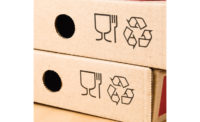It is obvious that the packaging world is taking sustainability in packaging — as well as operations — seriously. The numerous brands, retailers, suppliers and packaging companies that continue to change practices as well as offer lighter, recycled or reusable materials attest to it. But is it enough?
I wanted readers to really think when looking at this cover. What does it mean? I look at it as a symbol that out of all the types of recycled packaging, we can create a better planet for future generations by being cognizant of our actions.
Most of us know know what recyclable and sustainable materials offer. But there are some that just can’t be altered as much as others. And that’s OK because it isn’t a perfect world. Our goal is to try to move toward a better planet by doing as much as we can, as both an industry that affects recycling and sustainable practices, as well as consumers ourselves.
Producing less waste, minimizing thick films and other materials, and decreasing greenhouse gases and other energy in-house all helps.
E-commerce shipments have grown, which brings new challenges to combat product and packaging waste. In order to police all shipments for consumer goods, Amazon has given a deadline to CPGs to update their packaging to be greener, sturdier and cheaper to ship.
Brands often supply Amazon with the same inventory that they would put on a store shelf. Designing packaging that will stand up in a warehouse environment is different than designing packaging that is primarily designed to catch a shopper’s eye while displayed at retail.
New mono-layered films with same structure as multi-layered, compostable packaging and closures fit for rigorous transport have made worldwide appearances this past year.
I was recently in Florida and happened upon a boutique shop that sells T-shirts and sweatshirts made from recycled plastic. Bottles are shredded and spun, and then the material is made into clothing. 30A Gear (30agear.com) creates the Dumpster Diver shirts. Every 30A T-shirt is made from eight plastic bottles, and the sweatshirts save 24 bottles from landfills. I expected a rougher feel, but they’re blended with recycled cotton, so they’re unbelievably soft.
This month’s cover story features suppliers as well as brands that recently have taken the initiative to add or change packaging materials to be more environmentally friendly.
So, what does the cover mean to you?
KRISTEN KAZARIAN




